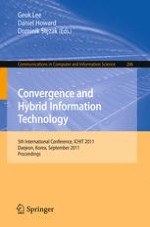This book constitutes the refereed proceedings of the 5th International Conference on Convergence and Hybrid Information Technology, ICHIT 2011, held in Daejeon, Korea, in September 2011. The 85 revised full papers presented were carefully reviewed and selected from 144 submissions. The papers are organized in topical sections on communications and networking; motion, video, image processing; security systems; cloud, RFID and robotics; industrial application of software systems; hardware and software engineering; healthcare, EEG and e-learning; HCI and data mining; software system and its applications.
